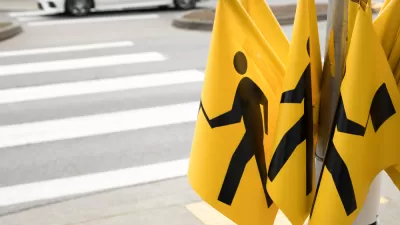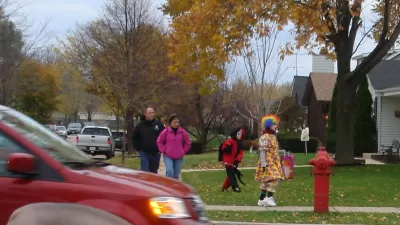The media coverage of a tragic crash in Cleveland shows how long of a leash drivers and street design get in the debate about traffic safety and the public realm.
"In downtown Cleveland Saturday night, a driver high on heroin struck and killed Jenasia Summers, 21, as she rode an electric scooter. But instead of questioning why Cleveland streets are so dangerous, the local press has responded by painting scooters as a safety hazard," writes Angie Schmitt.
Schmitt is criticizing the reporting and social media messaging of Cleveland.com, which, despite reporting in a separate article that the driver of the vehicle was on heroin, also tweeted a question about whether scooters are a cause for concern. An article earlier in the month describes the scooters as "incredibly dangerous," so there's a theme emerging in the publication's approach to electric scooters.
Schmitt is having none of it:
Scooters have been in the local headlines because the city recently told the start-up Bird to remove a fleet of 100 vehicles from public streets. Summers was not riding a Bird — she had rented an Icon scooter from a shop downtown. But whatever vehicle she was riding, it’s less relevant to this crash than Cleveland’s failure to make streets safer for walking, biking, or scooting.
The message echoes the tone of a previous article by Schmitt, which suggests that scooters are far more popular, and boring, than local media suggests. In that article, Schmitt also provides a level of nuance that's been rare in the discussion of electric scooters in that article: "Much of the scary news coverage has no doubt been motivated by fear of change — and, indeed, traveling by e-scooter in cities is a novel idea. In addition, the industry has been dominated by big tech firms who dump their products into public space first and ask for permission second (or not at all)."
FULL STORY: Scooters Aren’t a Public Safety Hazard. Dangerous Streets Designed Only for Cars Are.

Study: Maui’s Plan to Convert Vacation Rentals to Long-Term Housing Could Cause Nearly $1 Billion Economic Loss
The plan would reduce visitor accommodation by 25,% resulting in 1,900 jobs lost.

North Texas Transit Leaders Tout Benefits of TOD for Growing Region
At a summit focused on transit-oriented development, policymakers discussed how North Texas’ expanded light rail system can serve as a tool for economic growth.

Why Should We Subsidize Public Transportation?
Many public transit agencies face financial stress due to rising costs, declining fare revenue, and declining subsidies. Transit advocates must provide a strong business case for increasing public transit funding.

How to Make US Trains Faster
Changes to boarding platforms and a switch to electric trains could improve U.S. passenger rail service without the added cost of high-speed rail.

Columbia’s Revitalized ‘Loop’ Is a Hub for Local Entrepreneurs
A focus on small businesses is helping a commercial corridor in Columbia, Missouri thrive.

Invasive Insect Threatens Minnesota’s Ash Forests
The Emerald Ash Borer is a rapidly spreading invasive pest threatening Minnesota’s ash trees, and homeowners are encouraged to plant diverse replacement species, avoid moving ash firewood, and monitor for signs of infestation.
Urban Design for Planners 1: Software Tools
This six-course series explores essential urban design concepts using open source software and equips planners with the tools they need to participate fully in the urban design process.
Planning for Universal Design
Learn the tools for implementing Universal Design in planning regulations.
Ascent Environmental
Borough of Carlisle
Institute for Housing and Urban Development Studies (IHS)
City of Grandview
Harvard GSD Executive Education
Toledo-Lucas County Plan Commissions
Salt Lake City
NYU Wagner Graduate School of Public Service





























